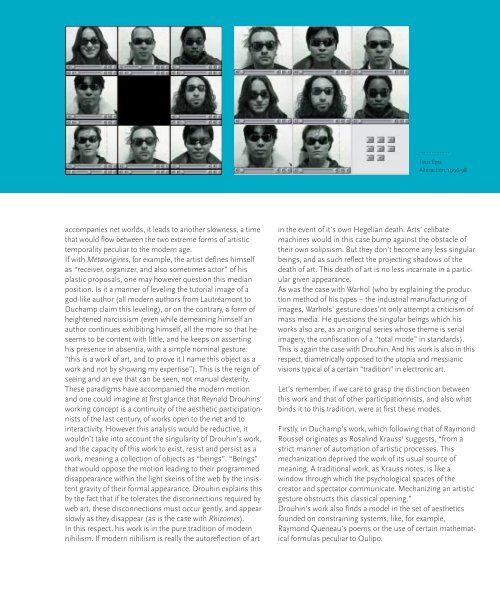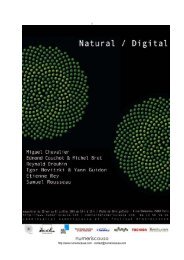Télécharger le pdf de la publication - Reynald Drouhin
Télécharger le pdf de la publication - Reynald Drouhin
Télécharger le pdf de la publication - Reynald Drouhin
Create successful ePaper yourself
Turn your PDF publications into a flip-book with our unique Google optimized e-Paper software.
accompanies net worlds, it <strong>le</strong>ads to another slowness, a time<br />
that would flow between the two extreme forms of artistic<br />
temporality peculiar to the mo<strong>de</strong>rn age.<br />
If with Métaorigines, for examp<strong>le</strong>, the artist <strong>de</strong>fines himself<br />
as “receiver, organizer, and also sometimes actor” of his<br />
p<strong>la</strong>stic proposals, one may however question this median<br />
position. Is it a manner of <strong>le</strong>veling the tutorial image of a<br />
god-like author (all mo<strong>de</strong>rn authors from Lautréamont to<br />
Duchamp c<strong>la</strong>im this <strong>le</strong>veling), or on the contrary, a form of<br />
heightened narcissism (even whi<strong>le</strong> <strong>de</strong>meaning himself an<br />
author continues exhibiting himself, all the more so that he<br />
seems to be content with litt<strong>le</strong>, and he keeps on asserting<br />
his presence in absentia, with a simp<strong>le</strong> nominal gesture:<br />
“this is a work of art, and to prove it I name this object as a<br />
work and not by showing my expertise”). This is the reign of<br />
seeing and an eye that can be seen, not manual <strong>de</strong>xterity.<br />
These paradigms have accompanied the mo<strong>de</strong>rn motion<br />
and one could imagine at first g<strong>la</strong>nce that <strong>Reynald</strong> <strong>Drouhin</strong>s’<br />
working concept is a continuity of the aesthetic participationnists<br />
of the <strong>la</strong>st century, of works open to the net and to<br />
interactivity. However this analysis would be reductive, it<br />
wouldn’t take into account the singu<strong>la</strong>rity of <strong>Drouhin</strong>’s work,<br />
and the capacity of this work to exist, resist and persist as a<br />
work, meaning a col<strong>le</strong>ction of objects as “beings”. “Beings”<br />
that would oppose the motion <strong>le</strong>ading to their programmed<br />
disappearance within the light skeins of the web by the insistent<br />
gravity of their formal appearance. <strong>Drouhin</strong> exp<strong>la</strong>ins this<br />
by the fact that if he to<strong>le</strong>rates the disconnections required by<br />
web art, these disconnections must occur gently, and appear<br />
slowly as they disappear (as is the case with Rhizomes).<br />
In this respect, his work is in the pure tradition of mo<strong>de</strong>rn<br />
nihilism. If mo<strong>de</strong>rn nihilism is really the autoref<strong>le</strong>ction of art<br />
...................<br />
Tous Ego,<br />
Alteraction, 1996-98<br />
in the event of it’s own Hegelian <strong>de</strong>ath. Arts’ celibate<br />
machines would in this case bump against the obstac<strong>le</strong> of<br />
their own solipsism. But they don’t become any <strong>le</strong>ss singu<strong>la</strong>r<br />
beings, and as such ref<strong>le</strong>ct the projecting shadows of the<br />
<strong>de</strong>ath of art. This <strong>de</strong>ath of art is no <strong>le</strong>ss incarnate in a particu<strong>la</strong>r<br />
given appearance.<br />
As was the case with Warhol (who by exp<strong>la</strong>ining the production<br />
method of his types – the industrial manufacturing of<br />
images, Warhols’ gesture does’nt only attempt a criticism of<br />
mass media. He questions the singu<strong>la</strong>r beings which his<br />
works also are, as an original series whose theme is serial<br />
imagery, the confiscation of a “total mo<strong>de</strong>” in standards).<br />
This is again the case with <strong>Drouhin</strong>. And his work is also in this<br />
respect, diametrically opposed to the utopia and messianic<br />
visions typical of a certain “tradition” in e<strong>le</strong>ctronic art.<br />
Let’s remember, if we care to grasp the distinction between<br />
this work and that of other participationnists, and also what<br />
binds it to this tradition, were at first these mo<strong>de</strong>s.<br />
Firstly, in Duchamp’s work, which following that of Raymond<br />
Roussel originates as Rosalind Krauss 1 suggests, “from a<br />
strict manner of automation of artistic processes. This<br />
mechanization <strong>de</strong>prived the work of its usual source of<br />
meaning. A traditional work, as Krauss notes, is like a<br />
window through which the psychological spaces of the<br />
creator and spectator communicate. Mechanizing an artistic<br />
gesture obstructs this c<strong>la</strong>ssical opening.”<br />
<strong>Drouhin</strong>’s work also finds a mo<strong>de</strong>l in the set of aesthetics<br />
foun<strong>de</strong>d on constraining systems, like, for examp<strong>le</strong>,<br />
Raymond Queneau’s poems or the use of certain mathematical<br />
formu<strong>la</strong>s peculiar to Oulipo.






